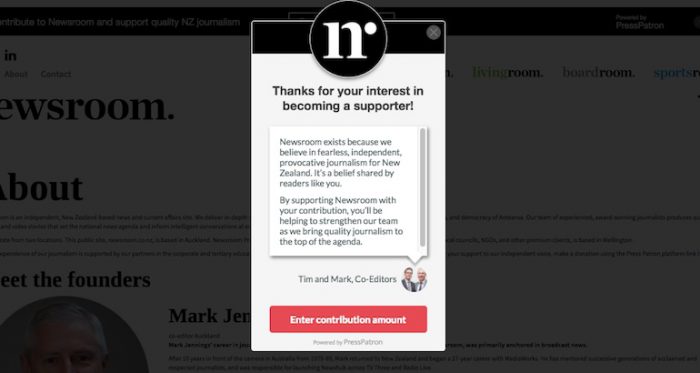
“People say you don’t value journalism because you’re not paying for the model, but I think the issue was they weren’t offered a model that resonated in the right way.”
That’s the premise on which Alex Clark has been building his journalism revenue startup PressPatron. It’s his attempt to bridge the paywalls and subscriptions of audience-supported journalism to encourage readers to pay what they want for news on a particular website. PressPatron started with Clark’s master’s thesis research in 2014 and is now crossing the Pacific from New Zealand to launch in the United States this fall.
PressPatron operates as the back-end platform for different publishers to support crowdfunding on their sites. Readers are prompted to make either a one-time or a monthly, recurring donation to the news organization through a small “powered by PressPatron” info box that pops up on their screen. The process can be completed without leaving the site. It includes a picture of the organization’s publisher and a message from the publisher to the reader. The goal is to have PressPatron integrated across a number of sites, so that audiences can recognize its name and take comfort in the familiarity.
Clark sees this as an opportunity to bridge the gap between declining advertising revenues and paywalls with low success rates.
“Ads don’t bring in anywhere near enough revenue. With paywalls, the conversion rate is super, super low and creates antagonism with readers,” he said. “We’re trying to encourage publishers to take down those barriers, to be able to reach a larger audience and have a higher revenue per user.”
The journalism market in Australia and New Zealand hasn’t always been keen on reader support and nonprofit news. Australian journalism academic Alexandra Wake wrote about the plight of one nonprofit news venture down under for Nieman Lab in 2014: The Global Mail had been operating on a pledge of $15 million over five years from one philanthropist, who turned away about two years in when his stock took a dive. In a post earlier this year on The Conversation, Wake noted that little had changed about the notion of paying for news in Australia:Though the news industry across the globe has been faced with hardships, Clark hopes that PressPatron can slide into the market at an opportune time: when readers are more willing to pay for news, and media organizations are more willing to try new things.Australia is considered a tough market for newspaper owners who are already fighting a difficult battle to keep paying readers and advertisers.
The latest Reuters Digital News Report declared that Australian publishers had ‘struggled to increase the number of digital subscribers beyond loyal users’ and that just 10 [percent] of Australians paid for news online. More specifically the report points to rising digital subscriptions for The Herald Sun and The Australian, while Fairfax publications the SMH and The Age, faced a small downturn after earlier increases.
Newspaper advertising dollars are also increasingly difficult to find. It’s not just because of competition from new foreign players in the Australian market, such as The Guardian and The Daily Mail.
Search engines like Google and Bing are taking massive amounts of advertising dollars away from the local mastheads. Last year PricewaterhouseCoopers predicted the newspaper advertising market in Australia will continue to drop sharply, that by 2020, advertising revenue will have more than halved in a decade.
In February PressPatron officially went live on the sites of New Zealand publishers like the independent news and current events website Newsroom and cultural commentary hub The Spinoff. Australian publishers introduced PressPatron to their sites in mid-August. The initial results seem promising.
Clark has done market research, though it’s limited. In 2014 he surveyed 416 people:
Within the survey, 1.4% of respondents said they’d definitely make a voluntary monthly contribution to their favorite news site or blogger, with an average amount of $11. A further 11.1% of respondents said they would probably contribute.
By comparison, only 0.24% of survey respondents said they would definitely subscribe to a news website that was locked behind content restrictions such as a paywall. A further 2.6% said they would probably subscribe.
In practice, however, things have been different, perhaps in part because in the last three years readers have become more comfortable with the idea of paying for journalism. So far, the average one-time contribution for PressPatron is 46.90 New Zealand dollars ($34.30) and the average monthly contribution is NZ$11.40. Supporters opt for monthly donations 60 percent of the time, but 37 percent of one-time donors give more than NZ$50, Clark said. In a feedback survey, supporters also noted that they appreciated the tool’s subtlety and convenience for donating to quality journalism without having to jump through hoops.
PressPatron is retaining 97 percent of supporters in its New Zealand markets so far. Clark noted that its conversion rate of the unique audiences across all publisher websites is 0.5 percent after only two months. It takes one to two years for the average paywall in the industry to reach that percentage, he said.
“There were more people willing to make these monthly donations than to pay for sites locked up [behind paywalls] which was a pretty cool finding,” he added.
PressPatron’s own funding comes out of a percentage of the donations as fees, though the company also raised funding from angel investors and institutions in New Zealand last year.
“It’s nice seeing the amount of goodwill and generosity that exists out there for journalism,” Clark said. “Contrary to popular belief, people do value journalism and care about it a lot.”